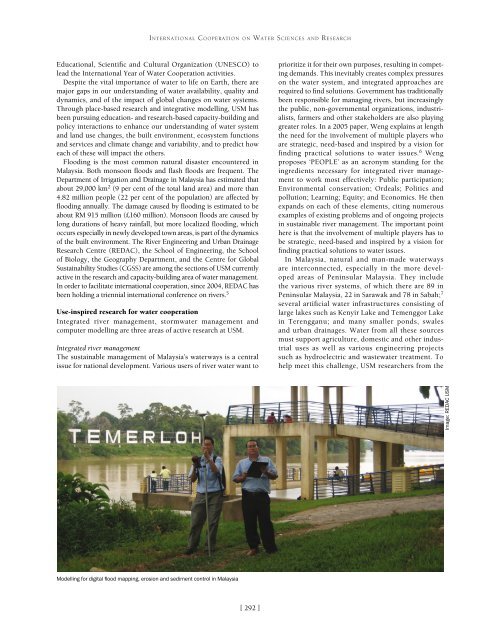Free Flow
oJhBl
oJhBl
You also want an ePaper? Increase the reach of your titles
YUMPU automatically turns print PDFs into web optimized ePapers that Google loves.
International Cooperation on Water Sciences and Research<br />
Educational, Scientific and Cultural Organization (UNESCO) to<br />
lead the International Year of Water Cooperation activities.<br />
Despite the vital importance of water to life on Earth, there are<br />
major gaps in our understanding of water availability, quality and<br />
dynamics, and of the impact of global changes on water systems.<br />
Through place-based research and integrative modelling, USM has<br />
been pursuing education- and research-based capacity-building and<br />
policy interactions to enhance our understanding of water system<br />
and land use changes, the built environment, ecosystem functions<br />
and services and climate change and variability, and to predict how<br />
each of these will impact the others.<br />
Flooding is the most common natural disaster encountered in<br />
Malaysia. Both monsoon floods and flash floods are frequent. The<br />
Department of Irrigation and Drainage in Malaysia has estimated that<br />
about 29,000 km 2 (9 per cent of the total land area) and more than<br />
4.82 million people (22 per cent of the population) are affected by<br />
flooding annually. The damage caused by flooding is estimated to be<br />
about RM 915 million (£160 million). Monsoon floods are caused by<br />
long durations of heavy rainfall, but more localized flooding, which<br />
occurs especially in newly developed town areas, is part of the dynamics<br />
of the built environment. The River Engineering and Urban Drainage<br />
Research Centre (REDAC), the School of Engineering, the School<br />
of Biology, the Geography Department, and the Centre for Global<br />
Sustainability Studies (CGSS) are among the sections of USM currently<br />
active in the research and capacity-building area of water management.<br />
In order to facilitate international cooperation, since 2004, REDAC has<br />
been holding a triennial international conference on rivers. 5<br />
Use-inspired research for water cooperation<br />
Integrated river management, stormwater management and<br />
computer modelling are three areas of active research at USM.<br />
Integrated river management<br />
The sustainable management of Malaysia’s waterways is a central<br />
issue for national development. Various users of river water want to<br />
prioritize it for their own purposes, resulting in competing<br />
demands. This inevitably creates complex pressures<br />
on the water system, and integrated approaches are<br />
required to find solutions. Government has traditionally<br />
been responsible for managing rivers, but increasingly<br />
the public, non-governmental organizations, industrialists,<br />
farmers and other stakeholders are also playing<br />
greater roles. In a 2005 paper, Weng explains at length<br />
the need for the involvement of multiple players who<br />
are strategic, need-based and inspired by a vision for<br />
finding practical solutions to water issues. 6 Weng<br />
proposes ‘PEOPLE’ as an acronym standing for the<br />
ingredients necessary for integrated river management<br />
to work most effectively: Public participation;<br />
Environmental conservation; Ordeals; Politics and<br />
pollution; Learning; Equity; and Economics. He then<br />
expands on each of these elements, citing numerous<br />
examples of existing problems and of ongoing projects<br />
in sustainable river management. The important point<br />
here is that the involvement of multiple players has to<br />
be strategic, need-based and inspired by a vision for<br />
finding practical solutions to water issues.<br />
In Malaysia, natural and man-made waterways<br />
are interconnected, especially in the more developed<br />
areas of Peninsular Malaysia. They include<br />
the various river systems, of which there are 89 in<br />
Peninsular Malaysia, 22 in Sarawak and 78 in Sabah; 7<br />
several artificial water infrastructures consisting of<br />
large lakes such as Kenyir Lake and Temenggor Lake<br />
in Terengganu; and many smaller ponds, swales<br />
and urban drainages. Water from all these sources<br />
must support agriculture, domestic and other industrial<br />
uses as well as various engineering projects<br />
such as hydroelectric and wastewater treatment. To<br />
help meet this challenge, USM researchers from the<br />
Image: REDAC USM<br />
Modelling for digital flood mapping, erosion and sediment control in Malaysia<br />
[ 292 ]


